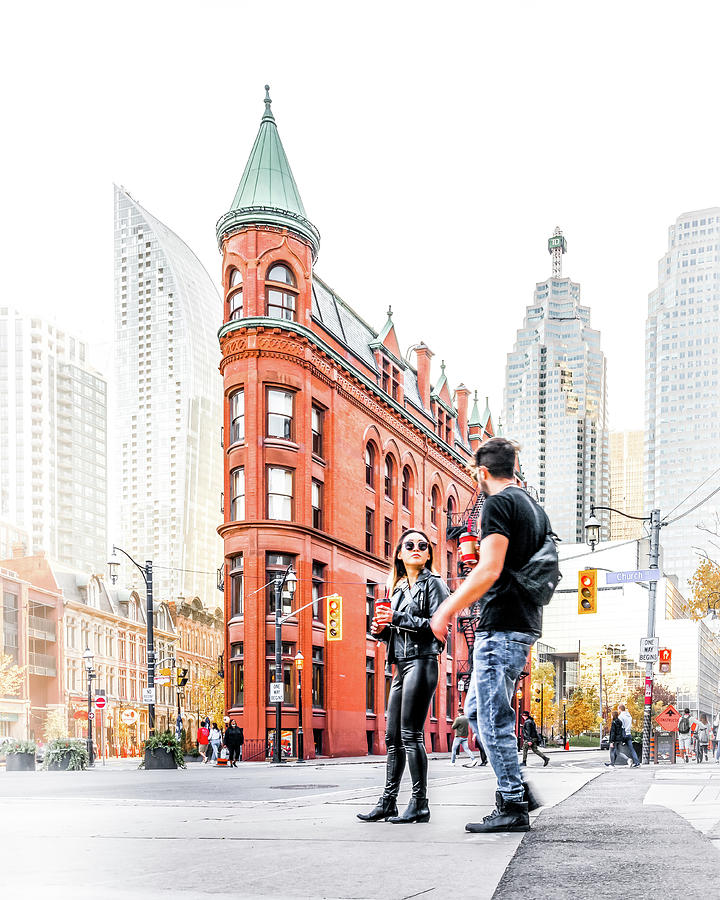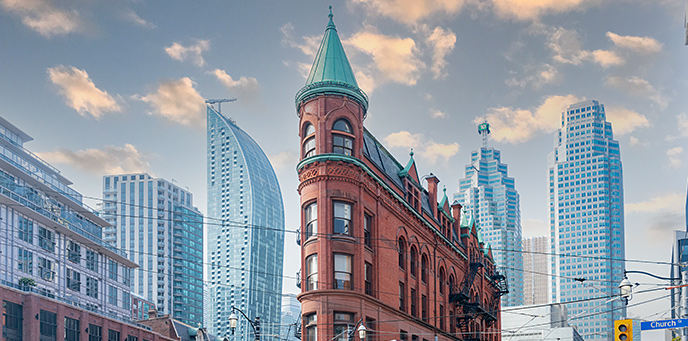Discover the Rich Background Behind the Gooderham Building in Toronto
The Gooderham Structure, an excellent indication of Richardsonian Romanesque architecture in Toronto, has a storied past that prolongs past its striking red brick frontage. Appointed by the significant Gooderham and Worts distillery in 1891, this structure has played an essential duty in shaping the metropolitan landscape of the St. Lawrence Market location. As we explore its origins, building importance, and cultural effect, one can not aid but examine how this site remains to affect Toronto's identity and heritage. What secrets lie within its wall surfaces that contribute to its enduring tradition?

Origins of the Gooderham Building
Building a long lasting legacy, the Gooderham Structure, also understood as the Flatiron Building, became a sign of Toronto's building development in the late 19th century. The structure's origins map back to 1891 when it was appointed by the Gooderham and Worts distillery, one of copyright's biggest distilling companies. Made by designer David Roberts Jr. Gooderham Building address., the structure was uniquely positioned at the junction of Front and Wellington Streets, capitalizing on a triangular whole lot developed by the convergence of these roads
The structure's building utilized local red brick and terracotta, establishing an unique visual that matched the expanding cityscape. Initially meant to house the Gooderham and Worts workplaces, the building represented the success of the distillery, which had actually come to be a considerable factor to Toronto's economy. Significantly, the completion of the Gooderham Structure synchronized with a period of rapid urbanization that defined the era.
The facility of this building gem not just showcased ingenious style yet also prepared for future advancements in Toronto. Today, it stands as a testament to the city's abundant history and versatility, proceeding to bring in site visitors and admirers from around the world.
Architectural Significance
The building value of the Gooderham Building extends beyond its unique flatiron form, showing the innovative spirit of late 19th-century style. Finished in 1892, the framework exhibits the Richardsonian Romanesque design, defined by its robust masonry, rounded arcs, and detailed describing. The strong usage of contrasting materials, especially the warm red block and limestone accents, enhances its visual appeal and demonstrates the craftsmanship of the era.
The building's three-story design is remarkable for its unified proportions and elegant cornice, which add to its iconic shape versus the Toronto sky line. The slim great deal on which it stands presented special difficulties, yet the designers, in this situation, created a framework that made best use of the readily available area while maintaining aesthetic equilibrium.
In Addition, the Gooderham Structure is a testimony to the adaptability of architectural design in metropolitan atmospheres. Its long-lasting existence in the middle of contemporary developments highlights the worth of protecting historic design as a way of recognizing a city's past. Today, it stays a beloved spots, showing both the architectural fads of its time and the progressing narrative of Toronto as a lively city center.
Duty in Toronto's Advancement
Becoming an essential player in Toronto's metropolitan landscape, the Gooderham Building added substantially to the city's advancement throughout the late 19th century. Constructed in 1892, this famous erection stood for not only the building aspirations of the time but also the blossoming economic landscape of Toronto. The structure was originally developed to function as a warehouse for the Gooderham and Worts distillery, which was one of the biggest distilleries in the British Empire. Its critical location at the junction of Front and Wellington Streets helped with the activity of goods and services, emphasizing the location's value in the city's commercial activities.
As the city expanded, the Gooderham Building ended up being a crucial component of the St. Lawrence Market area, which was a hub of trade and business. Its unique architectural style and noticeable existence attracted focus, affecting the design of subsequent buildings in the area. Additionally, the structure's survival through numerous financial shifts and metropolitan advancements mirrors the durability and flexibility of Toronto's historic landscape. Basically, the Gooderham Building is not just a building spots; it played a crucial duty fit Toronto's identification and financial growth throughout a transformative duration in its background.
Cultural Impact and Heritage
Gooderham Structure's unique architectural style and historical value have left an enduring mark on Toronto's social landscape. As one of the city's most identifiable landmarks, its unique flatiron form and elaborate brickwork exemplify the Victorian architectural trends of the late 19th century. This framework not only functions as a visual support in the St. Lawrence community but likewise symbolizes the spirit of a blossoming city throughout an era of financial growth.
The structure has come to be a symbol of Toronto's abundant history, inspiring regional artists and photographers that seek to capture its beauty. Its presence has actually cultivated a sense of area identification, adding to the narrative of city advancement. Furthermore, the Gooderham Structure has played a crucial duty in the tourist sector, bring in visitors excited to explore its fabled past and building appeal.
Along with its aesthetic charm, the structure encapsulates a story of resilience and adaptation, as it has actually transitioned through different usages over the decades - Gooderham Building address. Therefore, the Gooderham Structure stands not only as a monument of building importance however additionally as a testament to the progressing cultural heritage of Toronto

Reconstruction and Conservation Efforts
Many restoration and preservation initiatives have been carried out to make sure the Gooderham Building remains an essential part of Toronto's architectural heritage. Initially completed in 1892, the structure has actually gone through significant improvements to attend to structural problems while maintaining its historical honesty. One of the most significant remediation occurred in the late 20th century when the building was thoroughly refurbished to fulfill contemporary safety criteria without jeopardizing its initial layout elements.
These initiatives included repairing the unique red-brick façade, restoring the famous triangular form, and protecting the detailed masonry information. Additionally, the building's inside has seen mindful updates that respect its historic significance, ensuring that original functions such as wooden beam of lights and ornamental moldings are maintained.
The Gooderham Structure is now secured as a designated heritage building under the Ontario Heritage Act, which helps protect it from inappropriate modifications. Area engagement has played a crucial function in these conservation initiatives, with local campaigning for teams raising understanding regarding the structure's historical significance. Consequently, the Gooderham Structure stands not only as a functional area yet also as a testament to Toronto's rich building background and enduring cultural find this tradition.
Final Thought
Comments on “Gooderham Building Map: Parking, Address, and Nearby Sights.: How Weather and Close-by Spots Can Enhance Your Trip.}”